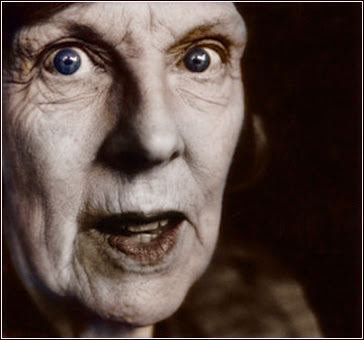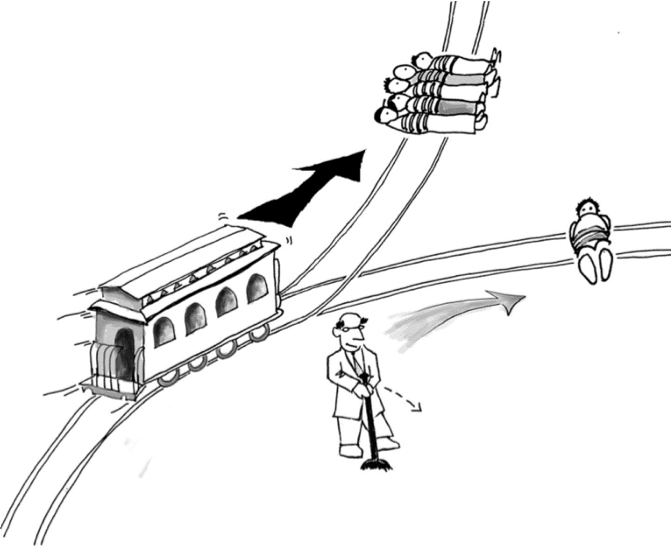Era 20th Century Role Philosopher Name Philippa Foot | Region Western philosophy Parents Esther Cleveland | |
 | ||
Died October 3, 2010, Madrid, Spain Grandparents Grover Cleveland, Frances Folsom Cleveland Preston Great-grandparents Ann Neal Cleveland, Richard Falley Cleveland Books Natural Goodness, Virtues and Vices and Other Ess, Moral Dilemmas: And Othe, Bondad Natural, Morality and Art Similar People | ||
Philippa foot trolley driver and transplant problems
Philippa Ruth Foot, FBA (; née Bosanquet; 3 October 1920 – 3 October 2010) was a British philosopher, most notable for her works in ethics. She was one of the founders of contemporary virtue ethics, inspired by the ethics of Aristotle. Her later career marked a significant change in view from her work in the 1950s and 1960s, and may be seen as an attempt to modernize Aristotelian ethical theory, to show that it is adaptable to a contemporary world view, and thus, that it could compete with such popular theories as modern deontological and utilitarian ethics. Some of her work was crucial in the re-emergence of normative ethics within analytic philosophy, especially her critique of consequentialism and of non-cognitivism. A familiar example is the continuing discussion of an example of hers referred to as the trolley problem. Foot's approach was influenced by the later work of Wittgenstein, although she rarely dealt explicitly with materials treated by him.
Contents
- Philippa foot trolley driver and transplant problems
- Virtue ethics rebirth of virtue ethics elizabeth anscombe and philippa foot
- Personal life and education
- Critique of non cognitivism
- Why be moral early works
- Why be moral middle works
- Why be moral later work
- Ethics aesthetics and political philosophy
- Selected works
- References

Virtue ethics rebirth of virtue ethics elizabeth anscombe and philippa foot
Personal life and education

Born as Philippa Ruth Bosanquet, Foot was the daughter of Esther Cleveland (1893-1980) and Captain William Sidney Bence Bosanquet (1893-1966) of the Coldstream Guards of the British Army. Her paternal grandfather was the barrister and judge, Sir Frederick Albert Bosanquet, Common Serjeant of London from 1900 to 1917. Her maternal grandfather was the 22nd and 24th President of the United States, Grover Cleveland.

Foot was educated privately and at Somerville College, Oxford, 1939–42, where she obtained a first class in Philosophy, Politics and Economics ('PPE'). Her association with Somerville, interrupted only by government service as an economist from 1942 to 1947, continued for the rest of her life. She was a lecturer in Philosophy, 1947–50, fellow and tutor, 1950–69, senior research fellow, 1969–88, and honorary fellow, 1988–2010. She spent many hours there in debate with G.E.M. Anscombe, who persuaded her that non-cognitivism was misguided.

In the 1960s and 1970s Foot held a number of visiting professorships in the United States - at Cornell, MIT, Berkeley, City University of New York. She was appointed Griffin Professor of Philosophy at the University of California, Los Angeles, in 1976 and taught there until 1991, dividing her time between the United States and England.

Contrary to common belief, Foot was not a founder of Oxfam and joined the organization about 6 years after its foundation. She was an atheist. She was once married to the historian M. R. D. Foot, and at one time shared a flat with the novelist Iris Murdoch. She died in Madrid in 2010, on her 90th birthday.
Critique of non-cognitivism

Foot's works of the late 1950s were meta-ethical in character: that is, they pertained to the status of moral judgment and speech. The essays Moral Arguments and Moral Beliefs, in particular, were crucial in overturning the rule of non-cognitivism in analytic approaches to ethical theory in the preceding decades.

The non-cognitivist approach may already be found in Hume, but it was given its most influential analytic formulations in works of A. J. Ayer, C. L. Stevenson, and R. M. Hare. These writers focused on so-called "thin ethical concepts" such as "good" and "bad" and "right" and "wrong," arguing that they are not employed to affirm something true of the thing in question, but rather, to express an emotion or (in Hare's case) an imperative.
This sort of analysis of "thin" ethical concepts was tied to a special partitioning account of more concrete or "thick" concepts, such as "cowardly", "cruel", or "gluttonous." These were supposed to combine a non-cognitive "evaluative" element with the obvious, "merely descriptive" element.
Foot's purpose was to criticize this distinction and the underlying account of thin concepts. Because of the particular way she approached the defense of the cognitive and truth-evaluable character of moral judgment, these essays were crucial in bringing the question of the rationality of morality to the fore.
Practical considerations involving "thick" ethical concepts – but it would be cruel, it would be cowardly, it's hers, or I promised her I wouldn't – move people to act one way rather than another, but they are as descriptive as any other judgment pertaining to human life. They differ from thought such as it would be done on a Tuesday or it would take about three gallons of paint, not by the admixture of what she considers to be any non-factual, attitude-expressing "moral" element, but by the fact that human beings have reasons not to do things that are cowardly or cruel.
Her lifelong devotion to this question appears in all periods of her work. It may be found in her continuing discussion of the Platonic immoralists, Callicles and Thrasymachus, and of Nietzsche. [citation needed]
"Why be moral?" – early works
It is on this question – the "why be moral?" question (which for her may be said to divide into the questions "why be just?", "why be temperate?", etc.) – that her doctrine underwent a surprising series of reversals. In Moral Beliefs, she had argued that the received virtues – courage, temperance, justice, and so on – are cultivated rationally, and that it was thus rational to act in accordance with them. The "thick" ethical concepts that she emphasized (without using this expression) in her defense of the cognitive character of moral judgment were associated with such rationally cultivated traits, i.e. virtues; this is how they differ from randomly chosen descriptions of action. The crucial point was that the difference between "just action" and "action performed on Tuesday" (for example) was not a matter of "emotive" meaning, as in Ayer and Stevenson, or a secret imperatival feature, as in Hare.
"Why be moral?" – middle works
Fifteen years later, in the essay Morality as a System of Hypothetical Imperatives, she reversed this when it came to justice and benevolence, that is, the virtues that especially regard other people. Although everyone has reason to cultivate courage, temperance and prudence, whatever the person desires or values, still, the rationality of just and benevolent acts must, she thought, turn on contingent motivations. Although many found the thesis shocking, on her (then) account, it is meant to be, in a certain respect, inspiring: in a famous reinterpretation of a remark of Kant, she says that "we are not conscripts in the army of virtue, but volunteers"Template:Virtues and Vices, p. 170; the fact that we have nothing to say in proof of the irrationality of at least some unjust people should not alarm us in our own defense and cultivation of justice and benevolence: "it did not strike the citizens of Leningrad that their devotion to the city and its people during the terrible years of the siege was contingent".
"Why be moral?" – later work
Her book Natural Goodness attempts a different line. The question what we have most reason to do, is tied to the idea of the good working of practical reason. This, in turn, is tied to the idea of the species of an animal as providing a measure of good and bad in the operations of its parts and faculties. Just as one has to know what kind of animal one is dealing with in order, for instance, to decide whether its eyesight is good or bad, the question of whether a subject's practical reason is well developed, depends on the kind of animal it is. (This idea is developed in the light of a conception of animal kinds or species as implicitly containing "evaluative" content, which may be criticized on contemporary biological grounds; although it is arguable, even on that basis, that it is very deeply entrenched in human cognition.) In our case, what makes for a well-constituted practical reason, depends on the fact that we are human beings characterized by certain possibilities of emotion and desire, a certain anatomy, neurological organization, and so forth.
Once this step is made, it becomes possible to argue for the rationality of moral considerations in a new way. Humans begin with the conviction that justice is a genuine virtue. Thus, the conviction that the well-constituted human practical reason operates with considerations of justice, means that taking account of other people in that sort of way is "how human beings live together." (The thought that this is how they live must be understood in a sense that is compatible with the fact that actual individuals often do not – just as dentists understand the thought that "human beings have n teeth" in a way that is compatible with many people having fewer). There is nothing incoherent in the thought that practical calculation that takes account of others and their good might characterize some kind of rational and social animal.
Similarly, of course, there is nothing incoherent in the idea of a form of rational life within which such considerations are alien; where they can only be imposed by damaging and disturbing the individual person. There is nothing analytic about the rationality of justice and benevolence. Rather, human conviction that justice is a virtue and that considerations of justice are genuine reasons for action, is the conviction that the kind of rational being that we are, namely, human beings, is of the first type. There is no reason to think such a kind of rational animality is impossible, so there is no reason to suspect that considerations of justice are frauds.
Of course, it might be suggested that this is precisely not the case, that human beings are of the second kind, and thus that the justice and benevolence we esteem are artificial and false. Foot would hold that considerations of machismo and lady-likeness are artificial and false; they are matters of "mere convention," which tend to put one off of the main things. That being how it is with justice, was the position of the Platonic "immoralists" Callicles and Thrasymachus, and that being how it is with benevolence, was the view of Nietzsche.
In the case of Callicles and Nietzsche, this apparently is to be shown by claiming that justice and benevolence, respectively, can be inculcated only by warping the emotional apparatus of the individual. Foot's book ends by attempting to defuse the evidence Nietzsche brings against what might be called, the common sense position. She proceeds by accepting his basic premise that a way of life that can only be inculcated by damaging the individual's passions, filling one with remorse, resentment, and so forth, is not true. She employs exactly the Nietzschean form of argument against certain forms of femininity, for example, or exaggerated forms of acceptance of etiquette. Justice and benevolence, she claims, however, "suit" human beings, and there is no reason to accept the critique of Callicles or Nietzsche in this case.
Ethics, aesthetics and political philosophy
Nearly all Foot's published work relates to normative or meta-ethics. Only once did she move across the boundary into aesthetics. This was in her 1970 British Academy Hertz Memorial Lecture, Art and Morality, in which certain contrasts are drawn between moral and aesthetic judgements. She appears never to have taken a professional interest in political philosophy. Geoffrey Thomas, of Birkbeck College, London, recalls approaching Foot in 1968, when he was a postgraduate student at Trinity College, Oxford, to ask if she would read a draft paper on the relation of ethics to politics. 'I've never found political philosophy interesting', she said. She added, 'One's bound to interest oneself in the things people around one are talking about', with the implication, perfectly correct, that political philosophy was largely out of favour with Oxford philosophers in the 1950s and 1960s. She still graciously agreed to read the paper. Thomas never sent it to her.
